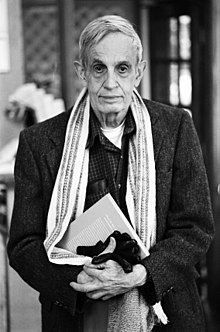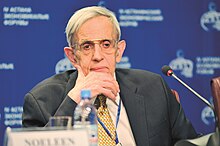John Forbes Nash, Jr.
Appearance
(Redirected from John Forbes Nash)

John Forbes Nash, Jr. (June 13, 1928 — May 23, 2015) was an American mathematician, who shared the 1994 Nobel Memorial Prize in Economic Sciences with game theorists Reinhard Selten and John Harsanyi. His works in game theory, differential geometry, and partial differential equations have provided insight into the factors that govern chance and events inside complex systems in daily life. His theories are used in market economics, computing, evolutionary biology, artificial intelligence, accounting, politics and military theory.
- See also:
Quotes
[edit]
1950s
[edit]- A less obvious type of application (of non-cooperative games) is to the study of cooperative games. By a cooperative game we mean a situation involving a set of players, pure strategies, and payoffs as usual; but with the assumption that the players can and will collaborate as they do in the von Neumann and Morgenstern theory. This means the players may communicate and form coalitions which will be enforced by an umpire. It is unnecessarily restrictive, however, to assume any transferability or even comparability of the pay-offs [which should be in utility units] to different players. Any desired transferability can be put into the game itself instead of assuming it possible in the extra-game collaboration.
- "Non-cooperative Games" in Annals of Mathematics, Vol. 54, No. 2 (September 1951); as cited in Can and should the Nash program be looked at as a part of mechanism theory? (2003) by Walter Trockel
- The writer has developed a “dynamical” approach to the study of cooperative games based upon reduction to non-cooperative form. One proceeds by constructing a model of the preplay negotiation so that the steps of negotiation become moves in a larger non-cooperative game [which will have an infinity of pure strategies] describing the total situation. This larger game is then treated in terms of the theory of this paper [extended to infinite games] and if values are obtained they are taken as the values of the cooperative game. Thus the problem of analyzing a cooperative game becomes the problem of obtaining a suitable, and convincing, non-cooperative model for the negotiation.
The writer has, by such a treatment, obtained values for all finite two-person cooperative games, and some special n-person games.- "Non-cooperative Games" in Annals of Mathematics, Vol. 54, No. 2 (September 1951)
- We give two independent derivations of our solution of the two-person cooperative game. In the first, the cooperative game is reduced to a non-cooperative game. To do this, one makes the players’ steps of negotiation in the cooperative game become moves in the noncooperative model. Of course, one cannot represent all possible bargaining devices as moves in the non-cooperative game. The negotiation process must be formalized and restricted, but in such a way that each participant is still able to utilize all the essential strengths of his position. The second approach is by the axiomatic method. One states as axioms several properties that it would seem natural for the solution to have and then one discovers that the axioms actually determine the solution uniquely. The two approaches to the problem, via the negotiation model or via the axioms, are complementary; each helps to justify and clarify the other.
- "Non-cooperative Games" in Annals of Mathematics, Vol. 54, No. 2 (September 1951)
1990s
[edit]

- I would not dare to say that there is a direct relation between mathematics and madness, but there is no doubt that great mathematicians suffer from maniacal characteristics, delirium and symptoms of schizophrenia.
- Statement of 1996, as quoted in Dr. Riemann's Zeros (2003) by Karl Sabbagh, p. 88
Autobiographical essay (1994)
[edit]- "Autobiographical essay" in Les Prix Nobel - The Nobel Prizes 1994 (1995) edited by Tore Frängsmyr
- By the time I was a student in high school I was reading the classic Men of Mathematics by E. T. Bell and I remember succeeding in proving the classic Fermat theorem about an integer multiplied by itself p times where p is a prime.
- As a graduate student I studied mathematics fairly broadly and I was fortunate enough, besides developing the idea which led to "Non-Cooperative Games," also to make a nice discovery relating to manifolds and real algebraic varieties. So I was prepared actually for the possibility that the game theory work would not be regarded as acceptable as a thesis in the mathematics department and then that I could realize the objective of a Ph. D. thesis with the other results.
- Gradually I began to intellectually reject some of the delusionally influenced lines of thinking which had been characteristic of my orientation. This began, most recognizably, with the rejection of politically-oriented thinking as essentially a hopeless waste of intellectual effort.
- At the present time I seem to be thinking rationally again in the style that is characteristic of scientists. However this is not entirely a matter of joy as if someone returned from physical disability to good physical health. One aspect of this is that rationality of thought imposes a limit on a person's concept of his relation to the cosmos.
- Statistically, it would seem improbable that any mathematician or scientist, at the age of 66, would be able through continued research efforts, to add much to his or her previous achievements. However I am still making the effort and it is conceivable that with the gap period of about 25 years of partially deluded thinking providing a sort of vacation my situation may be atypical. Thus I have hopes of being able to achieve something of value through my current studies or with any new ideas that come in the future.
2000s
[edit]- Though I had success in my research both when I was mad and when I was not, eventually I felt that my work would be better respected if I thought and acted like a 'normal' person.
- As quoted in A Beautiful Mind, (2001); also cited in Quantum Phaith (2011), by Jeffrey Strickland, p. 197
- People are always selling the idea that people with mental illness are suffering. I think madness can be an escape. If things are not so good, you maybe want to imagine something better. In madness, I thought I was the most important person in the world.
- As quoted in "A Brilliant Madness A Beautiful Madness (2002), PBS TV program; also cited in Doing Psychiatry Wrong: A Critical and Prescriptive Look at a Faltering Profession (2013) by René J. Muller, p. 62
- You don't have to be a mathematician to have a feel for numbers. A movie, by the way, was made — sort of a small-scale offbeat movie — called Pi recently. I think it starts off with a big string of digits running across the screen, and then there are people who get concerned with various things, and in the end this Bible code idea comes up. And that ties in with numbers, so the relation to numbers is not necessarily scientific, and even when I was mentally disturbed, I had a lot of interest in numbers.
- Statement of 2006, partly cited in Stop Making Sense: Music from the Perspective of the Real (2015) by Scott Wilson, p. 117
Quotes about Nash
[edit]
- This man is a genius.
- Richard Duffin, recommendation for Nash
- ... he gave his name to the Nash equilibrium – a position in a situation of competition or conflict in which both sides have selected a strategy, but where neither side can then independently change their strategy without ending up in a less desirable position. Such positions are common in everyday life, and in the interactions of business people, politicians and nations. He earned his early reputation, and his 1994 Nobel prize in economics, by proving mathematically that there is at least one Nash equilibrium lying in wait to trap us in every situation of competition or conflict where the parties are unwilling or unable to communicate.
- Len Fisher (25 May 2015)"John Nash obituary". The Guardian.
- He was always full of mathematical ideas, not only on game theory, but in geometry and topology as well. However, my most vivid memory of this time is of the many games which were played in the common room. I was introduced to Go and Kriegspiel, and also to an ingenious topological game which we called Nash in honor of the inventor.
- John Milnor, describing what Nash was like late 1940s, when Milnor was also a Princeton undergraduate, in "A Nobel prize for John Nash", in The Mathematical Intelligencer 17 (3) (1995), p. 11-17
- As I said, I spent a great deal of time in the common room, and so did Nash. He was a very interesting character and full of ideas. He also used to wander in the corridors whistling things like Bach, which I had never really heard before — a strange way to be introduced to classical music! I saw quite a bit of him over those years and I also became interested in game theory, in which he was an important contributor. He was a very interesting person.
- John Milnor, in Interview with John Milnor, by Martin Raussen and Christian Skau, The Newsletter of the European Mathematical Society (September 2011)
- When Freeman Dyson, the physicist, greeted John Forbes Nash, Jr. at the Institute for Advanced Study one day in the early 1990s, he hardly expected a response. A mathematics legend in his twenties, Nash had suffered for decades from a devastating mental illness. A mute, ghost-like figure who scrawled mysterious messages on blackboards and occupied himself with numerological calculations, he was known around Princeton only as “the Phantom.” To Dyson’s astonishment, Nash replied. He’d seen Dyson’s daughter, an authority on computers, on the news, he said. “It was beautiful,” recalled Dyson. “Slowly, he just somehow woke up.” Nash’s miraculous emergence from an illness long considered a life sentence was neither the first, nor last, surprise twist in an extraordinary life.
- Sylvia Nasar, in the Introduction to The Essential John Nash (2001), edited by Harold W. Kuhn & Sylvia Nasar
- [W]hile the book and the movie probed the conflicting complexities in Nash the man, neither delved deeply into Nash's math. So for most people today, his accomplishments remain obscure. Within the world of science, though, Nash's math now touches more disciplines than Newton's or Einstein's. What Newton's or Einstein's math did for the physical universe, Nash's math may now be accomplishing for the biological and social universe.
- Tom Siegfried, A Beautiful Math: John Nash, Game Theory, and the Modern Quest for a Code of Nature (2006) Introduction
- The tools introduced by Nash gave rise to new powerful theories (convex integration, Nash-Moser scheme) which later would allow to attack many mathematical problems.
- Cédric Villani, (November 2, 2016)"The Extraordinary Theorems of John Nash - with Cédric Villani". The Royal Institution, YouTube. (quote at 27:08 of 59:51)
External links
[edit]- Autobiographical essay at the official Nobel site
- John Forbes Nash at the MacTutor History of Mathematics archive
- Video of Dr. Sylvia Nasar narrating the story of John Nash at MIT


